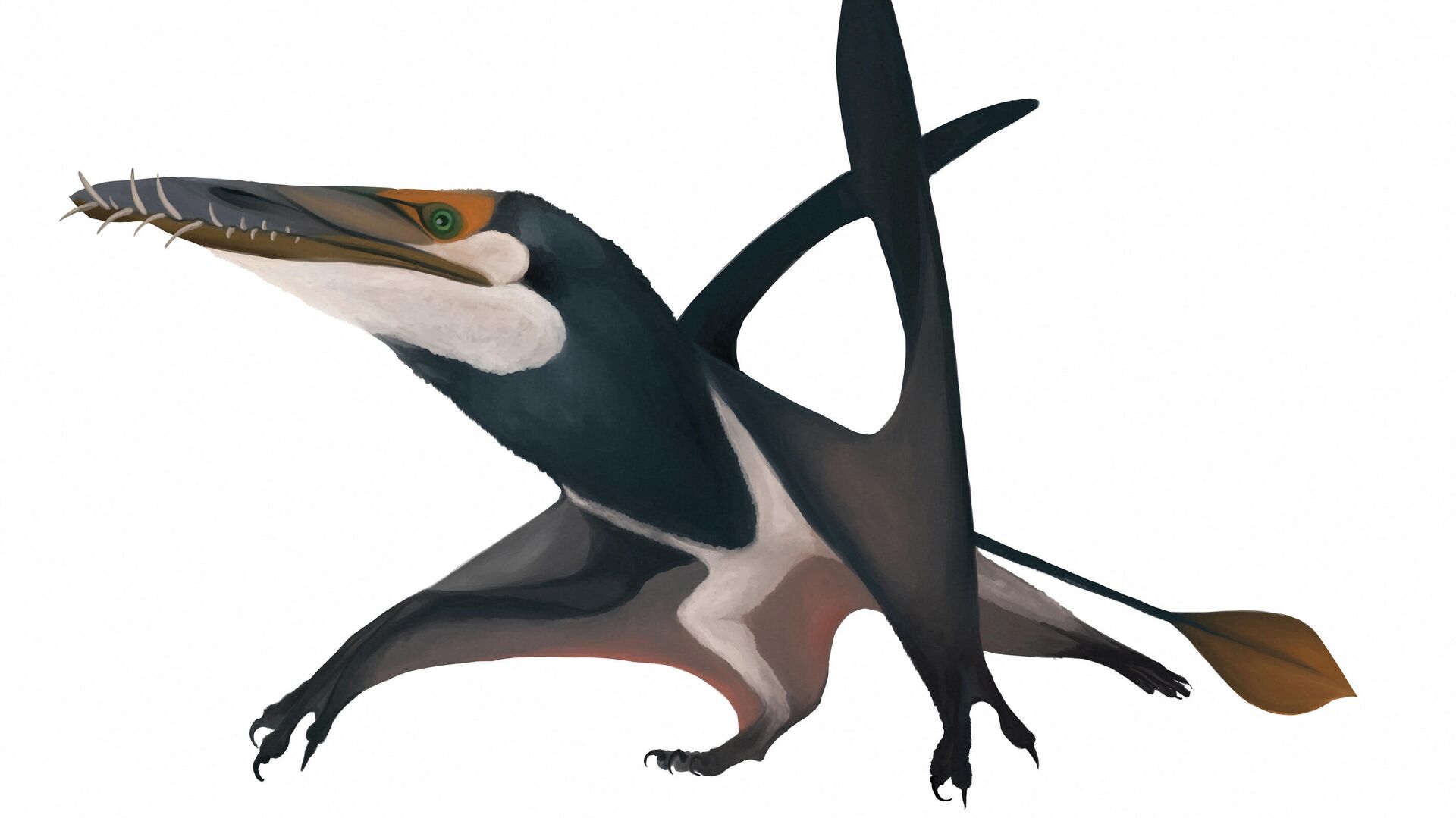https://sputnikglobe.com/20220223/170-million-year-old-fossil-found-in-scotland-belongs-to-largest-flying-dinosaur-from-jurassic-era-1093297882.html
170 Million-Year-Old Fossil Found in Scotland Belongs to Largest Flying Dinosaur From Jurassic Era
170 Million-Year-Old Fossil Found in Scotland Belongs to Largest Flying Dinosaur From Jurassic Era
Sputnik International
Pterosaurs were the first vertebrates to evolve powered flight some 50 million years before birds came into being. They lived during the Mesozoic era, often... 23.02.2022, Sputnik International
2022-02-23T11:26+0000
2022-02-23T11:26+0000
2023-05-28T15:18+0000
dinosaurs
jurassic-era
pterosaur
university of edinburgh
scotland
paleontology
fossil
earth
united kingdom (uk)
https://cdn1.img.sputnikglobe.com/img/07e6/02/17/1093298984_0:225:2843:1824_1920x0_80_0_0_ba238ae123efac49cde73a959beba0f6.jpg
A well-preserved fossil of a pterosaur, discovered on the Isle of Skye in Scotland, is being hailed as the "largest of its kind" from the Jurassic period.The specimen was discovered by Amelia Penny, a PhD student at the University of Edinburgh, during a field trip to the Isle of Skye in 2017, the National Museum of Scotland stated in an official statement released on Tuesday. "After the fossil was salvaged, it was brought to the University of Edinburgh for analysis and description. CT scans of the skull have revealed large optic lobes, which indicate that Dearc would have had good eyesight", stated the museum in the press release. The fossil is all set to be added to the museum's collection and studied further.The findings have also been documented in a new paper published in the peer-reviewed bi-weekly journal Current Biology.While palaeontologists have long known about the presence of similar-sized pterosaurs during the Cretaceous period, this is the first time they've found the presence of such large flying animals from the Jurassic era, or when dinosaurs came to symbolically rule the planet. Dinosaurs became extinct towards the end of the Mesozoic era, some 66 million years ago.Professor Brusatte also claims that the "superlative" Scottish fossil is probably the best British skeleton to have been discovered since the early 1800s.Natalia Jagielska, another PhD student at the University of Edinburgh and the lead author of the new paper, also remarks that "pterosaurs preserved in such quality are exceedingly rare".She notes that until now such discoveries have been confined to "select rock formations in Brazil and China"."Its sharp fish-snatching teeth still retain a shiny enamel cover as if he were alive mere weeks ago", she concludes.
https://sputnikglobe.com/20200528/pterosaur-species-fossil-discovered-in-britain-for-the-first-time-ever-1079446093.html
scotland
earth
united kingdom (uk)
Sputnik International
feedback@sputniknews.com
+74956456601
MIA „Rosiya Segodnya“
2022
News
en_EN
Sputnik International
feedback@sputniknews.com
+74956456601
MIA „Rosiya Segodnya“
Sputnik International
feedback@sputniknews.com
+74956456601
MIA „Rosiya Segodnya“
dinosaurs, jurassic-era, pterosaur, university of edinburgh, scotland, paleontology, fossil, earth, united kingdom (uk)
dinosaurs, jurassic-era, pterosaur, university of edinburgh, scotland, paleontology, fossil, earth, united kingdom (uk)
170 Million-Year-Old Fossil Found in Scotland Belongs to Largest Flying Dinosaur From Jurassic Era
11:26 GMT 23.02.2022 (Updated: 15:18 GMT 28.05.2023) Pterosaurs were the first vertebrates to evolve powered flight some 50 million years before birds came into being. They lived during the Mesozoic era, often referred to as the "age of reptiles". The Mesozoic era — divided into the Triassic, Jurassic, and Cretaceous periods — began some 252 million years ago and ended 66 million years ago.
A well-preserved fossil of a pterosaur, discovered on the Isle of Skye in Scotland, is being hailed as the "largest of its kind" from the Jurassic period.
Experts say that the giant creature, which has been named Dearc sgiathanach (Gaelic for "winged reptile"), lived on the planet nearly 170 million years ago and had a wing span of 2.5 metres, comparable to the modern-day albatross.
The specimen was discovered by Amelia Penny, a PhD student at the University of Edinburgh, during a field trip to the Isle of Skye in 2017, the National Museum of Scotland stated in an official statement released on Tuesday.
"After the fossil was salvaged, it was brought to the University of Edinburgh for analysis and description. CT scans of the skull have revealed large optic lobes, which indicate that Dearc would have had good eyesight", stated the museum in the press release.
The fossil is all set to be added to the museum's collection and studied further.
The findings have also been documented in a new paper published in the peer-reviewed bi-weekly journal Current Biology.
While palaeontologists have long known about the presence of similar-sized
pterosaurs during the Cretaceous period, this is the first time they've found the presence of such large flying animals from the
Jurassic era, or when dinosaurs came to symbolically rule the planet.
Dinosaurs became extinct towards the end of the Mesozoic era, some 66 million years ago.
"Dearc is the biggest pterosaur we know from the Jurassic period and that tells us that pterosaurs got larger much earlier than we thought, long before the Cretaceous period when they were competing with birds, and that's hugely significant", says Professor Steve Brusatte, a paleontologist at the University of Edinburgh.
Professor Brusatte also claims that the "superlative" Scottish fossil is probably the best British skeleton to have been discovered since the early 1800s.
Natalia Jagielska, another PhD student at the University of Edinburgh and the lead author of the new paper, also remarks that "pterosaurs preserved in such quality are exceedingly rare".
She notes that until now such discoveries have been confined to "select rock formations in Brazil and China".
"To achieve flight, pterosaurs had hollow bones with thin bone walls, making their remains incredibly fragile and unfit to preserve for millions of years. And yet our skeleton, 160 million years on since its death, remains in almost pristine condition, articulated and almost complete", explains Jagielska.
"Its sharp fish-snatching teeth still retain a shiny enamel cover as if he were alive mere weeks ago", she concludes.




